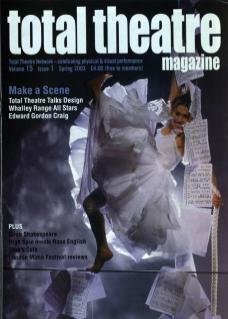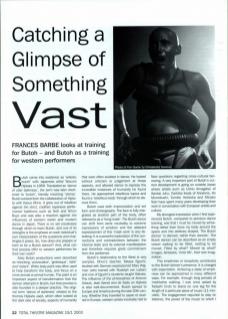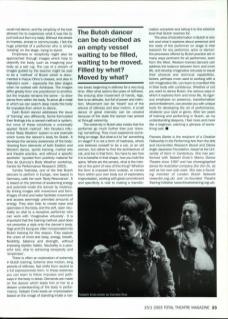Butoh came into existence as 'ankoku butoh' with Japanese artist Tatsumi Hijikata in 1959. Translated as 'dance of utter darkness', the term was later shortened to 'butoh', literally meaning 'stamp'. Butoh evolved from the collaboration of Hijikata with Kazuo Ohno. It grew out of rebellion against the strict, codified Japanese performance traditions such as Noh and Nihon Buyo and was also a reaction against the influences of western ballet and modern dance in Japan. There is no set vocabulary through which to learn Butoh, and one of its strengths is the emphasis on each individual's own interpretation of the questions and challenges it poses. So, how does one prepare or train to be a Butoh dancer? And, what can that process offer to western performers for their own work?
Early Butoh productions were described as 'shocking’, 'provocative', 'grotesque', 'dark and violent'. White body paint was often used to help transform the body, and focus on a more animal or primal human. The paint is an important aspect of transformation that the dancer attempts in Butoh, but that process is also founded in a deeper practice. The original term 'dance of darkness' related to the themes Hijikata used, which often looked at the dark side of society, aspects of humanity that were often avoided in dance. He looked without criticism or judgement at those aspects, and allowed dance to express the incredible instances of humanity he found there. He approached rebellious topics and found a 'rebellious body’ through which to discuss them.
Butoh uses both improvisation and set form and choreography. The face is fully integrated as another part of the body, often referred to as ‘a living mask'. The Butoh dance can shift from eerie neutrality to extreme expressions of emotion and the abstract expressionism of this mask work is very liberating. It is a powerful exploration of the connections and contradictions between the internal state and its external manifestation and therefore requires great commitment from the performer.
Butoh's relationship to the West is very complex. Ohno's teacher, Takaya Eguchi, studied with German expressionist Mary Wigman (who trained with Rudolph von Laban) and one of Eguchi's students taught Hijikata. The influence of the philosophies of Antonin Artaud, Jean Genet and de Sade on Hijikata is also well-documented. Butoh spread to Europe and America during the late 20th Century. Whether they travelled to Japan or studied in Europe, western artists inevitably had to face questions regarding cross-cultural borrowing. A very important part of Butoh's current development is going on outside Japan where artists such as Ushio Amagatsu of Sankai Juku, Carlotta Ikeda of Ariodone, Ko Murrobushi, Yumiko Yoshioka and Minako Seki have spent many years developing their work in conversation with European artists and culture.
My strongest impression when I first experienced Butoh, compared to previous dance training, was that I must be moved by something rather than force my body around the space and into arbitrary shapes. The Butoh dancer is danced, rather than dances. The Butoh dancer can be described as an empty vessel waiting to be filled, waiting to be moved. Filled by what? Moved by what? Images, fantasies, ‘inner life', their own imagination.
This emptiness or receptivity contributes to the Butoh dancer's presence. It is charged with expectation. Achieving a state of emptiness can be approached in many different ways. For example, through long periods of meditative walking. I was once asked by Tadashi Endo to stand on one leg for the length of a particular piece of music (11 minutes). The engagement required to stay on balance, the power of the music to which I could not dance, and the simplicity of the task allowed me to experience what it was like to just look out from my body. Without the desire to impress, emote or communicate, I felt the huge potential of a performer who is simply 'existing' on the stage, trying to stand.
Emptiness or receptivity might also be approached through images which help to objectify the body, such as imagining your body as a wet rug. The use of a stream of images guided by the teacher might be said to be a 'method’ of Butoh which is documented in Kazuo Ohno's classes, and also in Hijikata's work – especially the later stages when he worked with Ashikawa. The images differ greatly from one practitioner to another, but the impulse remains the same – to draw dance from within the body. To arrive at a state in which we can search deep inside the body for impulses from which to dance.
The Butoh dancer can be described as an empty vessel waiting to be filled, waiting to be moved. Filled by what? Moved by what?
Each Butoh dancer addresses the issue of training very differently. Some formulated their findings into a named method or system, but none of these constitute a universally applied 'Butoh method'. Min Tanaka's influential 'Body Weather' system is one example which tunes the dancer's body for Butoh. It develops the sensory awareness of the body: 'drawing from elements of both Eastern and Western dance, sports training, martial arts and theatre practice, and without a specific aesthetic’ (quoted from publicity material for Tess de Quincey's Body Weather workshop, Centre for Performance Research 2002).
Yumiko Yoshioka, one of the first Butoh dancers to perform in Europe, now based in Germany, calls her work 'Body Resonance'. It is based on the premise of awakening energy and potential inside the dancer by inextricably linking images with movement and form. Images of wind and water facilitate movement and access seemingly unlimited amounts of energy. They also help to create ease and openness in the body, and the soft, open neutrality so vital to a receptive performer who can work with 'imaginative virtuosity’. It is important that the training method used does not prescribe a style onto the dancer's body. Yoga and Chi Gung are often incorporated into Butoh training for this reason. They explore the union of mind and body, energy, breath, flexibility, balance and strength, without imposing stylistic habits. Neutrality is a powerful tool, vital to achieving receptivity and 'emptiness'.
There is often an exploration of extremity in Butoh training. Extreme slow motion, long periods of stillness, fast shifts from neutral to a full expressionistic form. In these extremes you can learn to follow impulses and pathways in the body in detail. Demands are made on the dancer which leads him or her to a deeper understanding of the body in performance. Tadashi Endo leads an improvisation based on the image of standing inside a narrow tower, beginning in stillness for a very long time. After what seems like years of stillness, the ensuing slow movement of hands, legs, feet is so delicate, but full of power and intention. Movement can be heard out of the silence of stillness and slow motion. A small dance of great intensity can be created because of the state the dancer has arrived at through extremity.
The extremity in Butoh also insists that the performer go much further than just 'showing’ something. They must experience something on stage. But what is it to be something on stage? It is not a form of madness, where one believes oneself to be a cat, or an old woman, but rather to find the architecture of cat, and live in that form. You have to see how it is to breathe in that shape, how you hold the spine. Where are the senses, what is the interest or the point of view of this thing? Whether the form is imposed from outside, or comes from within your own body out of exploratory improvisation, working with great commitment and specificity is vital to making a transformation complete and taking it to the extreme level that Butoh reaches for.
The area of transformation in Butoh is very rich and what it explores about presence and the state of the performer on stage is vital research for any performer, actor or dancer: the processes offered by Butoh practice are in many ways pertinent for all performers, even from the West. Western-trained dancers can address the balance between form and inner life, and develop imaginative virtuosity to equal their physical and technical capabilities. Actors, perhaps more used to working with a rich imaginative life, can learn to manifest this in their body with confidence. Whether or not you want to dance Butoh, the various ways in which it explores form and inner life, its rigorous emphasis on presence, transformation and embodiment, can provide you with unique tools for developing the art of performance, whatever your style or genre. After ten years of training and performing in Butoh, as my understanding deepens, I feel more and more like a beginner, catching a glimpse of something vast.
Frances Barbe is the recipient of a Creative Fellowship in the Performing Arts from the Arts and Humanities Research Board and Daiwa Anglo Japanese Foundation, based at the University of Kent in Canterbury. She has performed with Tadashi Endo's Mamu Dance Theatre since 1997 and has choreographed dance for Australian company Zen Zen Zo, as well as her own solo work. She was a founding member of London Butoh Network (www.lbn.org.uk) and co-founded Theatre Training Initiative (www.theatretraining.org.uk).


